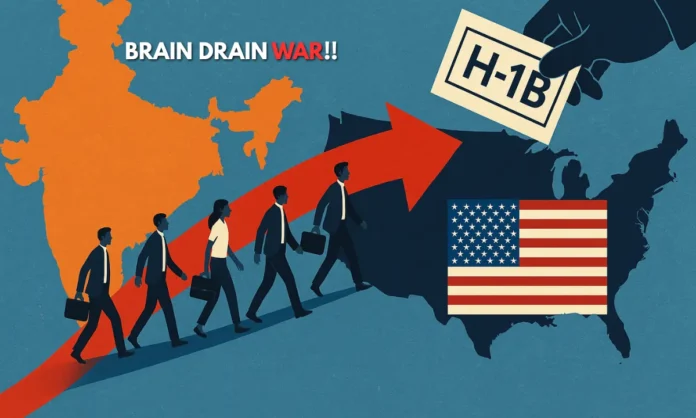SUMMARY
- A viral post claims the U.S. is “slowly killing India” by absorbing 70–75% of its top tech talent through the H-1B visa system.
- Critics argue the real issue is India’s inability to retain talent due to weak R&D, red tape, and poor job security.
- The debate reveals deeper fault lines over brain drain, national strategy, and the global power struggle for knowledge workers.
A Breeding Ground or a Broken Pipeline?
A viral social media post has reignited India’s age-old anxiety: that its most promising minds are leaving en masse, powering America’s tech ascent while stunting India’s own development. The post in question doesn’t mince words—it accuses the U.S. of “slowly killing India” by absorbing nearly 75% of all global H-1B visa allotments, a majority of which go to Indian professionals. “India is just a breeding ground,” it concludes grimly, citing comparative H-1B distributions that show China and South Korea retaining more of their top talent.
The figures are stark: over 70% of all H-1B visa holders in recent years have been Indian. In contrast, China accounts for about 10–12%, and South Korea a mere 1–2%. Critics argue that while China and Korea rise, India continues to bleed its intellectual capital.
The post struck a nerve for a reason. As India touts its demographic dividend and digital innovation surge, its best engineers, coders, and researchers are still boarding one-way flights to the West. But is the U.S. to blame—or is India simply failing to offer a reason to stay?
Internet divided over U.S. “killing” India by draining its top talent through the H-1B visa pool https://t.co/5EYB5hxCnf
— Financial Express (@FinancialXpress) May 20, 2025
The Echo Chamber: Backlash and Nationalist Narratives
- Some Americans accuse Indian tech workers of “stealing” high-paying U.S. jobs and degrading workplace culture.
- Others see Indian success in Silicon Valley as proof of merit, not exploitation.
- Indian netizens are split: “Is this extraction or opportunity?”
The backlash was swift and two-sided. On U.S. forums, one thread read: “Indians are the ones slowly killing the U.S.” The complaint? That Indian tech workers have driven down wages, crowded out domestic talent, and diluted American office culture. Another user called it “corporate colonization in reverse.”
But on the flip side, defenders of the Indian diaspora argue that their success is earned—and strategic. “The U.S. isn’t begging for Indian engineers. Indians are choosing the U.S. because India doesn’t reward them,” one user posted.
Others echoed the sentiment that this isn’t exploitation—it’s rational choice. If India doesn’t fund R&D, cuts public university budgets, and tolerates job market volatility, how can it expect its brightest to stay?
Between Patriotic Guilt and Global Strategy
- Many Indians abroad contribute via remittances, startup investments, and intellectual capital.
- Yet India’s long-term innovation capacity is stifled when top-tier talent exits.
- Structural reforms—not sentiment—may be the key to reversing the outflow.
For years, India’s brain drain narrative was built on guilt. Talented youth were seen as betraying the nation by leaving. Today, the conversation is more pragmatic. Experts note that many return with global experience and start businesses, while others send back billions in remittances. In 2024 alone, India received over $125 billion in remittances—the highest in the world.
Still, numbers don’t tell the full story. What India loses is harder to quantify: unrealised patents, missed scientific breakthroughs, and a hollowing out of its research institutions. The problem is not the mobility of talent but the immobility of reform.
From visa policies to academic funding to startup incentives, India’s talent ecosystem is ripe for disruption. And as one viral comment put it, “Imagine a country where even the prime minister praises those who leave. That’s not ambition. That’s surrender.”
Migration or Extraction? Rethinking the Global Talent Equation
The H-1B visa program was never just about paperwork—it’s a window into the aspirations, anxieties, and geopolitical strategies of nations. India’s dominance in the H-1B queue is both a testament to its educational system and a warning sign of its economic model. When a nation educates its elite only to see them serve another economy, questions of sovereignty and sustainability arise.
Is this dynamic symbiotic, parasitic, or simply inevitable in a globalized world? The answers won’t come from viral posts but from long-term policy shifts. For now, one thing is clear: the real debate isn’t about who wins the talent war—it’s about who builds the battlefield worth staying on.


